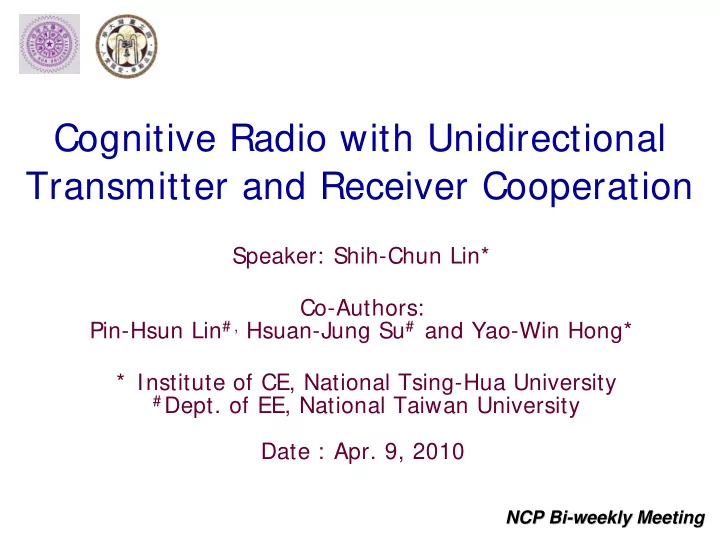

Cognitive Radio with Unidirectional Transmitter and Receiver Cooperation Speaker: Shih-Chun Lin* Co-Authors: Pin-Hsun Lin # , Hsuan-Jung Su # and Yao-Win Hong* * Institute of CE, National Tsing-Hua University # Dept. of EE, National Taiwan University Date : Apr. 9, 2010 NCP Bi- -weekly Meeting weekly Meeting NCP Bi
Outline Outline • Introduction and System Model • Cognitive Radio with Unidirectional Transmitter (UT) Cooperation • Cognitive Radio with Unidirectional Transmitter and Receiver (UTR) Cooperation • Numerical examples • Conclusion
Introduction and System Model Introduction and System Model NCP Bi- -weekly Meeting weekly Meeting NCP Bi
Interference- -Mitigation Based Mitigation Based Interference Cognitive radio Cognitive radio Simultaneously Silence [Interference avoidance] [Interference mitigation] [Courtesy from N. Devroye, P. Mitran and V. Tarokh, Limits on Communication in a Cognitive Radio Channel," IEEE Communications Magazine, 2006]
Cognitive radio with coexistence constraint Cognitive radio with coexistence constraint • Jovicic & Vishwanath’s cognitive radio signaling: – PR’s signal non-causally known at the CR-TX – Single user decoder at the PR RX – CR-TX relays PR’s signal to maintain PR’s rate, and uses the dirty paper coding (DPC) to cancel the interference from PR PR-TX PR-RX 1 4 DPC 2 3 CR-TX CR-RX A. Jovicic and P. Viswanath, “Cognitive radio: An information-theoretic perspective,” IEEE Trans. Inform. Theory, vol. 55, no. 9, pp. 3945–3958, Sept. 2009
Motivation : (cont’ ’d) d) Motivation : (cont • Pros of [JV09] : Optimal when |H 24 |< |H 23 | • Cons of [JV09] : – ` ` Noisy’’ relaying of the PR’s signal may be inefficient when |H 24 | is large or CR’s power is high – Assume |H 12 |> > |H 14 | to neglect decoding delay at Node 2 – The complexity of practical dirty paper coding (DPC) implementations may be still inhibitive in current communication systems.
Cognitive Radio with Unidirectional Cognitive Radio with Unidirectional Transmitter (UT) Cooperation Transmitter (UT) Cooperation NCP Bi- -weekly Meeting weekly Meeting NCP Bi
Unidirectional Transmitter (UT) Cooperation Unidirectional Transmitter (UT) Cooperation • Three phase protocol (Half-duplex Node 2 and 3) • Add two phases to JV scheme : – Phase 1 : Listening – Phase 3 : “Clean” relaying
UT Cooperation UT Cooperation • Phase 1: Node 2 listens and decodes PR’s message • Phase 2: Node 2 transmits the DPC encoded signal DPC with relay X 1 SI X 1 • Phase 3: Node 2 relays “clean” signals
Transmitter Side- -Information Constraint Information Constraint Transmitter Side • Successful listening at Phase 1 : To attain enough mutual information R 1 (Rate of PR) at Node 2
Coexistence Constraint Coexistence Constraint R 1 • Although the SNR at the three phases are different, from [CP89], Node 4 can still use single user decoder with rate R 1 if the “average SNR” over three phases are large enough • [JV06] neglected the listening phase, thus the conventional Shannon coding theorem worked T. M. Cover and S. Pombra, “Gaussian feedback capacity,” IEEE Trans. Inform. Theory, vol. 35, no. 1, pp. 37–43, Jan. 1989.
Achievable rate of UT Achievable rate of UT • If the system parameters selected meet previous constraints, then by the classical DPC result, the following rate is achievable by UT
Cognitive Radio with Unidirectional Cognitive Radio with Unidirectional Transmitter and Receiver (UTR) Transmitter and Receiver (UTR) Cooperation Cooperation NCP Bi- -weekly Meeting weekly Meeting NCP Bi
Unidirectional transmitter and receiver Unidirectional transmitter and receiver (UTR) cooperation (UTR) cooperation • Besides UT, the UTR cooperation has advantages – Diversity from H 34 – Works when H 12 is low and decode at Node 2 fail – CR user uses the conventional MAC encoder/decoder instead of the complex DPC
UTR Cooperation UTR Cooperation • Phase 1: Node 2 and Node 3 listens and decodes PR’s message • Phase 2: Node 2 transmits Conventional relay X 1 Gaussian signal • Phase 3: Node 2 and Node 3 relays “clean” signals
Achievable rate of UTR MAC with common message • From [LU06], the transmitted signal in Phase 2 is optimal for MAC with common msg = > using conventional MAC decoder • If the system parameters selected meet constraints as those in UT, we can use the achievable rate of the MAC channel to find the UTR achievable rate. N. Liu and S. Ulukus, “Capacity region and optimum power control strategies for fading Gaussian multiple access channels with common data,” IEEE Trans. Commun., pp 1815–1826, 2006.
Numerical examples Numerical examples • UT V.S. JV • UTR V.S. JV NCP Bi- -weekly Meeting weekly Meeting NCP Bi
Environments (UT V.S. JV) Environments (UT V.S. JV) • Same average power: Total power of Node 2 & 3 of UTR at Phase 3 meets • |H 24 |> |H 34 | UT is better than UTR 1/4H 12 1 4 H 12 2 H 12 1 . 5 1+ j H 12 2 3 H 12 1 / 2
UT V.S. JV UT V.S. JV
Environments (UTR V.S. JV) Environments (UTR V.S. JV) Same average power with JV: : |H 34 |> |H 24 | UTR is better than UT 1/4H 12 1 4 H 12 2 H 12 2 2 1+ j H 12 2 3 H 12 1 / 2
UTR V.S. JV UTR V.S. JV
Conclusion Conclusion • We proposed two new cooperation methods for CR system with coexistence constraint , i.e, the UT and UTR cooperation • The key ideas are – relay “clean” signals in the last phase – Receiver cooperation • Numerical examples confirm the rate gains of the proposed protocols
Future works Future works • Parameter optimization • High SNR analysis • Extensions to ergodic Rayleigh fading channels
Thanks and Questions !
Recommend
More recommend